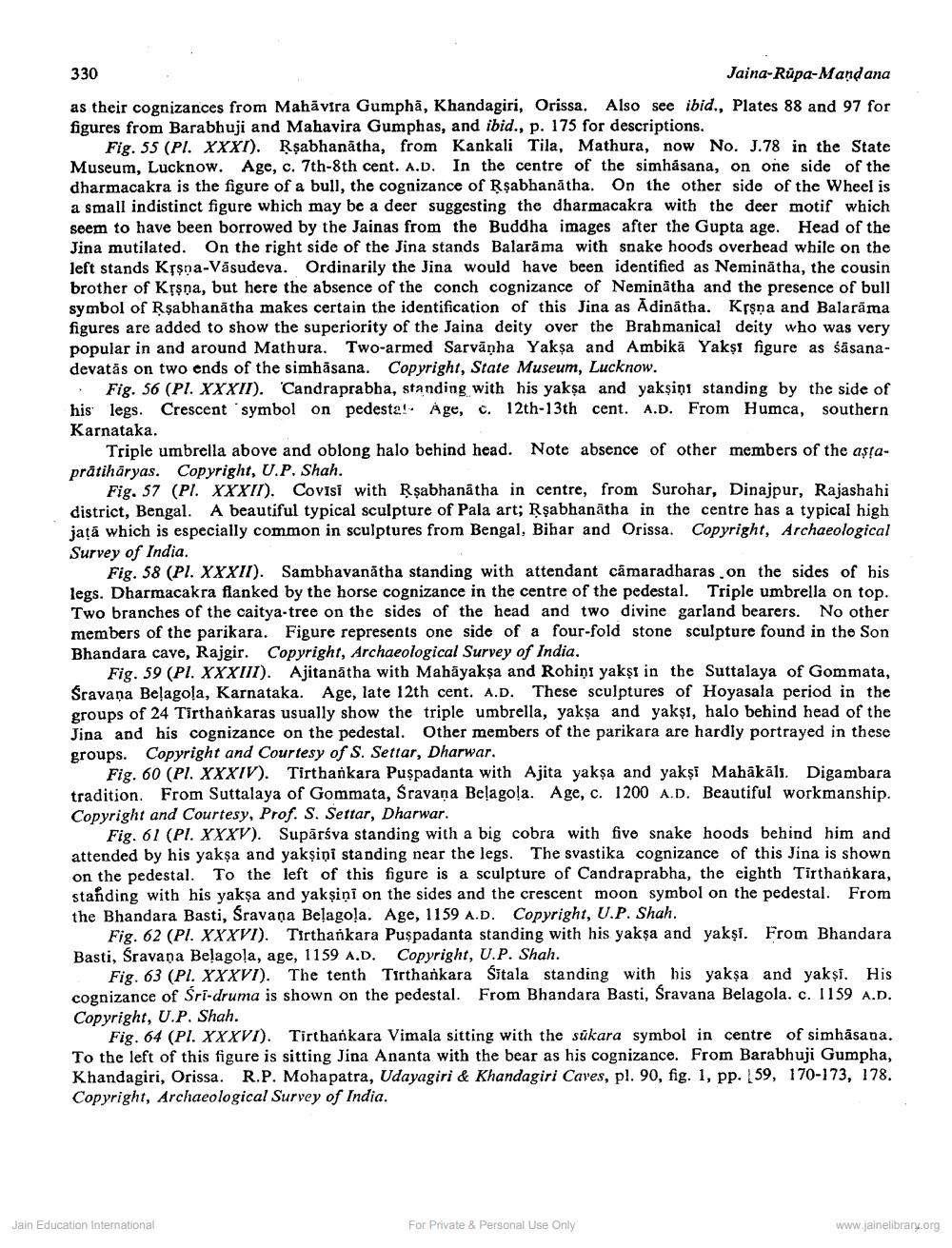________________
330
Jaina-Rupa-Mandana as their cognizances from Mahāvira Gumpha, Khandagiri, Orissa. Also see ibid., Plates 88 and 97 for figures from Barabhuji and Mahavira Gumphas, and ibid., p. 175 for descriptions.
Fig. 55 (Pl. XXXI). Rşabhanátha, from Kankali Tila, Mathura, now No. J.78 in the State Museum, Lucknow. Age, c. 7th-8th cent. A.D. In the centre of the simhasana, on one side of the dharmacakra is the figure of a bull, the cognizance of Rşabhanātha. On the other side of the Wheel is a small indistinct figure which may be a deer suggesting the dharmacakra with the deer motif which seem to have been borrowed by the Jainas from the Buddha images after the Gupta age. Head of the Jina mutilated. On the right side of the Jina stands Balarama with snake hoods overhead while on the left stands Kļşa-Vasudeva. Ordinarily the Jina would have been identified as Neminātha, the cousin brother of Krsna, but here the absence of the conch cognizance of Neminātha and the presence of bull symbol of Rşabhanātha makes certain the identification of this Jina as Adinatha. Krsna and Balarāma figures are added to show the superiority of the Jaina deity over the Brahmanical deity who was very popular in and around Mathura. Two-armed Sarvāṇha Yaksa and Ambika Yakşi figure as säsanadevatās on two ends of the simhāsana. Copyright, State Museum, Lucknow.
Fig. 56 (Pl. XXXII). 'Candraprabha, standing with his yaksa and yakşini standing by the side of his legs. Crescent symbol on pedesta!. Age, c. 12th-13th cent. A.D. From Humca, southern Karnataka.
Triple umbrella above and oblong halo behind head. Note absence of other members of the astaprätihāryas. Copyright, U.P. Shah.
Fig. 57 (Pl. XXXII). Covisi with Rşabhanātha in centre, from Surohar, Dinajpur, Rajashahi district, Bengal. A beautiful typical sculpture of Pala art; Rşabhanātha in the centre has a typical high jațā which is especially common in sculptures from Bengal, Bihar and Orissa. Copyright, Archaeological Survey of India.
Fig. 58 (Pl. XXXII). Sambhavanátha standing with attendant camaradharas on the sides of his legs. Dharmacakra flanked by the horse cognizance in the centre of the pedestal. Triple umbrella on top. Two branches of the caitya-tree on the sides of the head and two divine garland bearers. No other members of the parikara. Figure represents one side of a four-fold stone sculpture found in the Son Bhandara cave, Rajgir. Copyright, Archaeological Survey of India.
Fig. 59 (Pl. XXXIII). Ajitanātha with Mahāyakșa and Rohini yakşt in the Suttalaya of Gommata, Sravaņa Beļago!a, Karnataka. Age, late 12th cent. A.D. These sculptures of Hoyasala period in the groups of 24 Tirthankaras usually show the triple umbrella, yaksa and yakşi, halo behind head of the Jina and his cognizance on the pedestal. Other members of the parikara are hardly portrayed in these groups. Copyright and Courtesy of S. Settar, Dharwar.
Fig. 60 (Pl. XXXIV). Tirthankara Puspadanta with Ajita yakșa and yakși Mahākāls. Digambara tradition. From Suttalaya of Gommata, Sravana Bela gola. Age, c. 1200 A.D. Beautiful workmanship. Copyright and Courtesy, Prof. S. Settar, Dharwar.
Fig. 61 (PI. XXXV). Supārśva standing with a big cobra with five snake hoods behind him and attended by his yaksa and yaksini standing near the legs. The svastika cognizance of this Jina is shown on the pedestal. To the left of this figure is a sculpture of Candraprabha, the eighth Tirtharkara, standing with his yaksa and yaksiņi on the sides and the crescent moon symbol on the pedestal. From the Bhandara Basti, Sravana Belago!a. Age, 1159 A.D. Copyright, U.P. Shah.
Fig. 62 (Pl. XXXVI). Tirthankara Puspadanta standing with his yaksa and yaksi. From Bhandara Basti, Sravana Belagola, age, 1159 A.D. Copyright, U.P. Shah.
Fig. 63 (Pl. XXXVI). The tenth Tirthankara Sitala standing with his yaksa and yaksi. His cognizance of Sri-druma is shown on the pedestal. From Bhandara Basti, Sravana Belagola. c. 1159 A.D. Copyright, U.P. Shah.
Fig. 64 (Pl. XXXVI). Tirthankara Vimala sitting with the sükara symbol in centre of simhasana. To the left of this figure is sitting Jina Ananta with the bear as his cognizance. From Barabhuji Gumpha, Khandagiri, Orissa. R.P. Mohapatra, Udayagiri & Khandagiri Caves, pl. 90, fig. 1, pp. 59, 170-173, 178. Copyright, Archaeological Survey of India.
Jain Education International
For Private & Personal Use Only
www.jainelibrary.org




